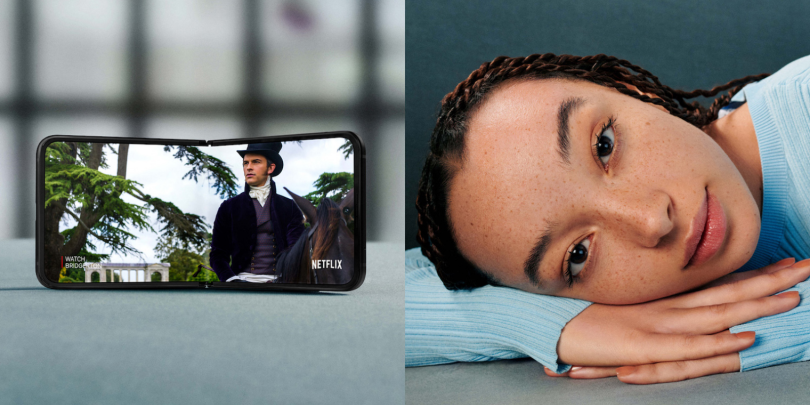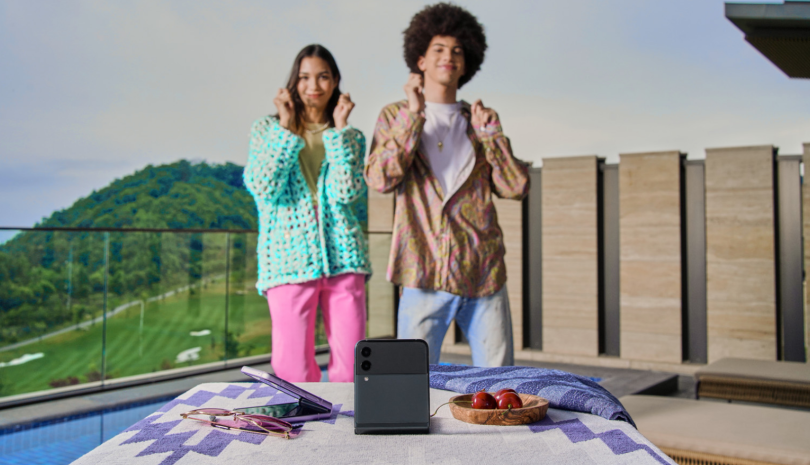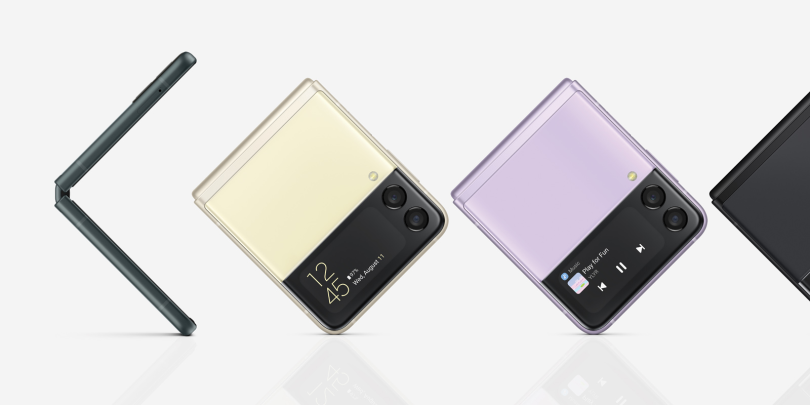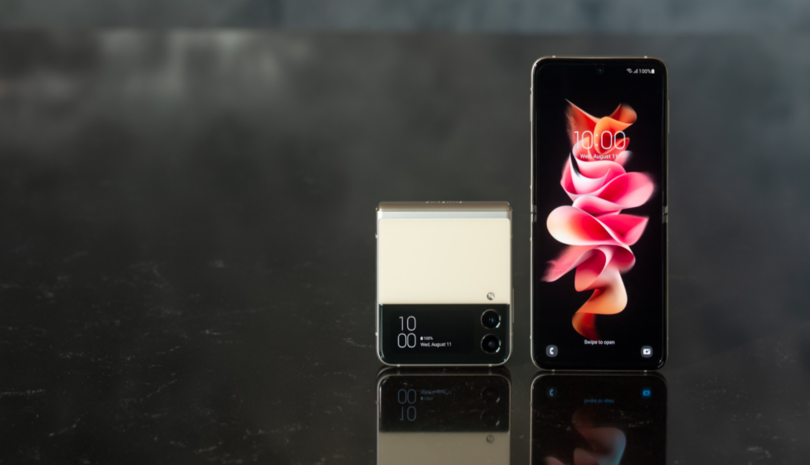The first weekend Nick Hahn toyed with his Samsung Galaxy Z Flip3 5G back in October, he drew looks. A product design manager at Meta overseeing the Facebook Stories design group, Hahn was on a business trip to New York — and wherever he went, people wanted to see his phone.
“I swear every person on the subway, at restaurants, at bars, was, like, ‘Is that your phone?’ ‘What is that?’” Hahn said.
Novelty is no doubt something Samsung believes will help the third generation of its folding-screen technology gain mainstream appeal. Dressed in ultra-thin glass, the compact flip phone fits into a shallow pocket — with little risk of a pocket dial. A 1.9-inch cover screen lets you skim messages, control the music player and take pictures without opening the phone. Lay it on its side, hinge slightly bent, and you can stream a movie in landscape mode. Prop it on its back and you can take a selfie or capture video at a comfortable distance, without worrying your carefully balanced phone will fall over or screw up the angle.
If the iPhone is king of candy bars, Samsung wants to change the recipe.
For Hahn, who upgrades his phone at least once every year, the Flip’s first generation missed the mark. It was pricey, about $1,400, and users reported that the screen scratched easily — or in some cases broke entirely when a polymer layer, often mistaken for a screen protector, was removed.
Since then the price has come down to $1,000, the glass has been re-engineered for durability, and as a Guardian reviewer observed: “The hinge has been refined, the design on the outside is less showy and it feels a bit more sturdy.”
Those improvements appear to be winning over new users. But Hahn said Samsung’s interest in folding screen technology may be less about the immediate appeal of its third-generation Flip and Fold phones, and more rooted in a long-term strategy to lead the transition away from the solid brick form factor that has dominated the last 15 years. If the iPhone is king of candy bars, Samsung wants to change the recipe.
At CES 2022 in Las Vegas, the company introduced the Flex 3, a tablet-sized device that opens to a three-panel screen; the Flex G, a phone that folds inward like a tri-fold wallet; and a phone with an expandable pull-out rail. Samsung even showed off a cylindrical 12-inch speaker that unfurls like a scroll of parchment paper.
The future of smartphones is hard to predict. The Slovenian writer Mitja Rutnik, in a blog post for Android Authority, speculates about scenarios from mind-reading devices, to long-distance over-the-air chargers and phones with e-ink displays akin to those on the Amazon Kindle — or even the replacement of smartphones with augmented reality glasses that project games, TV shows and photos in a user’s field of vision, like “Google Glass on steroids.” But whatever the future holds, Samsung seems committed to the idea that stretchable displays will be a defining part of it.
Eric Chan, president of ECCO Design, who has consulted on smartphone designs for LG, HTC and Lenovo, acknowledged that introducing hinges and flexible glass makes phones more susceptible to damage: creases, bubbles, cracks. It also requires extensive research and prototyping, which can be costly to undergo.
But Samsung’s market position may give it a unique perspective. Over time, it’s safe to presume display resolution will improve, battery life will improve, circuitry will get tinier and more sophisticated. But to Chan, all this ignores a more fundamental question: “How is a human being to enjoy the technology at their fingertip?”
For Samsung, which specializes in hardware and doesn’t create its own operating system, the answer lies in the physical qualities of the thing itself, said Mark Prommel, a partner at the industrial design and invention firm Pensa.
“The world of apps and services available through the operating system are almost the entire reason why people choose a smartphone,” Prommel said. “It’s like, ‘Well, I want the iOS operating system or I want the Android operating system.’”
Samsung wants to change that. Though the Galaxy Z Flip3 5G certainly draws on the flip-phone archetype, Prommel said, it’s more accurate to call it a flexible phone. It’s not just the hinge that bends, it’s the ultra-thin glass, which is flexible precisely because it is so thin: just 30-microns thick, or roughly the thickness of a human hair. Out-of-the-gate experimentation with the elasticity of the glass substrate may give Samsung an edge over competitors like Huawei and Microsoft, which are also pursuing foldable devices but may be late to the party.
A New Form Factor Means New Use Cases
Even as is, the phone unlocks several new uses.
One of the features Samsung foregrounds in its web promotions is the split-screen view. Drag and drop an app to the top or bottom of the screen, repeat with a second app, and voila! They lock into place. A soft blue line dividing the display can be touched and dragged to change the size ratio, which works in both landscape or portrait views. That means you can watch YouTube while texting a friend, checking the weather or doing whatever else you want to do in the second window.

But Hahn told me rarely uses the phone this way. What he does like to do is bend the phone at a slight angle, set it on a table or night stand and watch movies without having to crane his neck.
“It’s a little awkward if you’re watching a video and there’s panning left and right. You get like a quasi-bend to the image,” he said. “But it’s nice, because it’s quite stable.”

Chan told me the self-standing capability of the phone, a formal asset that was recognized as far back as 1876 when Alexander Graham Bell unveiled one of the earliest phones at the Centennial Exhibition in Philadelphia, may be especially appealing to gamers, who can play at a more comfortable posture. And for the growing number of creators who make TikTok videos, a hands-free device that can be set up at an optimal distance and angle for a well-balanced composition is likely to score points.

The phone’s real showstopper, though, may be the cover screen, Hahn said. Because texts and notifications appear on the screen, users can thumb through messages without opening the phone. The option to vet incoming calls and texts at a glance is nice, and you might be less likely to get sucked into a world of apps at the wrong time. (A handy feature since 9 of 10 Americans are offended when someone they are speaking with looks at their phone.)
The push-button operability of three external cameras and the standout quality of the photographs they can take is another key feature. Double-clicking the power button launches a camera app. Hitting the power button a third time takes a photo, or you can hold down the volume button and record video.
The Hinge Design Needs Work. Or Maybe to Go Away Entirely.
Much has been written about the glass itself: Whether it is glass at all, which manufacturers are involved in the material science behind the scenes (the German company Schott made flexible glass for the Galaxy Z Flip; the American material science and technology firm Corning reportedly worked with Samsung in subsequent iterations); and whether the phone is durable enough for mainstream use.
While some of these questions are somewhat subjective, Chan believes the glass vulnerabilities on the surface have largely been solved, but the exposed area near the hinge remains troublesome. When he experimented with the phone recently at Best Buy, he noticed a slight bulge from the AMOLED display — not bad enough to make the device unusable but noticeable enough to feel bad. I tried the phone myself at Target, and, though the touchscreen felt quite smooth, as Chan suggested, it didn’t close perfectly flush.

Two hinges, spanning a width of 17.1mm, help stabilize the phone as it bends. Like the gutter between the inseam and spine of a hardbound book, there is a small air gap between the hinges and glass screen when the phone is closed. Imagine folding a piece of microfiche.
Eliminating this gap through a hingeless roll-out display or a larger folding radius could be a logical next step for the designers, Chan said, as it would make the phone feel sturdier and improve the smoothness of interactions near the fold.
Samsung claims the “Galaxy Z series devices undergo rigorous folding tests to outlast 200,000 folds — or around five years of use if folded and unfolded 100 times a day.” Research sponsored by the insurance company Asurion found average users check their phones 96 times per day, or about once every 10 minutes. For users 18-24, who check their phones twice that often, or people who are rough on their phones, the phone’s durability might fall short.
Even still, Chan believes younger users, who tend to replace their phones within three years, aren’t motivated by durability so much as functionality and aesthetics. User reviews, which tend to be positive, seem to echo this sentiment.
Limited battery life remains a common complaint in such forums, however, presumably a function of the relatively small battery the design accommodates and the ease of running multiple apps at once. Hahn said the phone’s 3300mAh (typical) dual battery typically only lasts about half a day before he needs to recharge it. Yet, with wireless chargers in his car, office and home, this isn’t terribly restrictive.
Will Flexible Screens Usher in the End of the Candy-Bar Smartphone?
Prommel believes Samsung has overcome a key development hurdle, reaching “the point where you can fold it 180 degrees on a very fine crease and not have any lasting issue with the screen,” thereby making it a viable consumer product.
That, of course, is only step one. Samsung’s long game, he told me, may be to make the traditional smartphone obsolete, either by a convergence of existing devices, like voice controlled wireless buds and smart watches, where Samsung is pushing hard, or the creation of an entirely new form that offers the productive capacity of a laptop or PC. Either way, the idea is for the device to become more weightless and invisible to users, a seamless part of their experience rather than an external appendage.
“If you look at people’s lifestyles and real estate, the things of value they carry on their bodies, we’re starting to see a lot of things go away,” Prommel said. “The camera’s already gone. The wallet is going away. Keys are going away. We’re kind of down to the smartphone. Now, you can start to say, ‘I don’t need a tablet anymore. I don’t need a laptop anymore. I can carry this single thing that is very lightweight and handles all those things for me.’”
Even at a small profit margin, the viability of the smartphone gives Samsung room to maneuver. Whether what emerges is a multi-fold phone, a slide-out rail, a translucent display or something else entirely, Chan said, the plausible goal is to give users extra real screen estate when they need it, but let them put it away — out of sight and protected — when they don’t.
Conceivably, within 10 years, the candy-bar smartphone may give way to a new paradigm: a pocket-sized analog to LG’s rollable 65” OLED TV, which unfurls, in accordion folds, from a box. (You can watch it being unrolled here). When you’re done using your phone, you simply roll it up and put it in your pocket.
“That feels like the future,” Hahn said. “And I think there’s going to be more of that, where we unroll a screen or see films that stick to devices.”
Advances in flexible display technology could also open the door for more immersive experiences: for instance, a screen that flexes responsively in a first-person shooter game or a kinetic translation of human gestures. “Are we moving toward a place where you can use a device to send someone a hug based on actually manipulating the screen?” Prommel asked. “Or bookmarking something you’re browsing by folding down the corner of the screen?”
“If you look at people’s lifestyles and real estate, the things of value they carry on their bodies, we’re starting to see a lot of things go away ... The camera’s already gone. The wallet is going away. Keys are going away. We’re kind of down to the smartphone.
The technology is not there yet, he conceded. But that kind of interaction could be on the horizon. North, a company Google acquired in June of 2020, which developed smart glasses that use augmented reality to project holograms in a user’s retinal display, could be a foretaste of what lies ahead: wearable display devices that, over time, usurp or at least compliment many of the functions now offered by smartphones.
Even further afield, could come the integration of neural decoding devices being developed by software companies like Elon Musk’s Neuralink; Blackrock Neurotech and Paradromics. Using implanted electrodes to decipher brain signals in cortical structures that produce movement and speech, these devices might be able, for instance, to send a simple text message by reading your thoughts. That might sound far-fetched, but considering how far phones have advanced since Bell reportedly spoke his first words to his assistant Thomas Watson — “Mr. Watson – come here – I want to see you”— at the Centennial Exhibition in June 1876, it doesn’t require a great leap of imagination to get there.
“I had the experience recently of getting a bunch of Christmas cards in the mail,” Prommel said. “More than once, without thinking about it, I caught myself attempting to pinch a physical photo to zoom in, because it’s so ingrained in us now. But I think we’ve kind of reached the limit of what those gestures are.”
Hello, future. Is that you? Are you there?




